| Listing 1 - 10 of 15 | << page >> |
Sort by
|
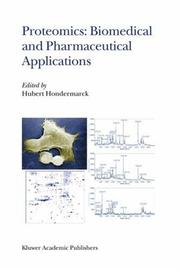
ISBN: 1402023235 1402023227 Year: 2004 Publisher: New York, New York : Kluwer Academic Publishers,
Abstract | Keywords | Export | Availability | Bookmark
 Loading...
Loading...Choose an application
- Reference Manager
- EndNote
- RefWorks (Direct export to RefWorks)
Human biology has now entered into a phase of post-genomics and it might not be an exaggeration to say that the major outcome of the human genome sequencing has finally been to open the way to the exploration of the proteome-proteomics. Proteins are the functional output of genes and there are two main expected outcomes from human proteomics. The first is to discover new molecular markers for early diagnosis and profiling of pathologies. The second is to decipher the intracellular signaling pathways leading to the initiation and progression of pathologies, for the identification of new targets and the development of innovative therapeutic strategies. This is clearly a promising challenge that this book explores through a series of ongoing experiences and projects representative of the new era in which biology and medicine have now entered.
Medicine. --- Proteomics. --- Biomedicine. --- Biomedicine general. --- Biomedicine, general. --- Molecular biology --- Proteins --- Health Workforce
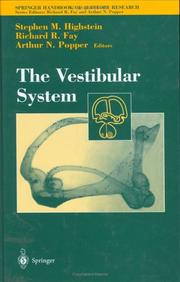
ISBN: 1280189428 9786610189427 0387215670 0387983147 Year: 2004 Publisher: New York, NY : Springer New York : Imprint: Springer,
Abstract | Keywords | Export | Availability | Bookmark
 Loading...
Loading...Choose an application
- Reference Manager
- EndNote
- RefWorks (Direct export to RefWorks)
The Springer Handbook of Auditory Research presents a series of comp- hensive and synthetic reviews of the fundamental topics in modern au- tory research.The volumes are aimed at all individuals with interests in hearing research, including advanced graduate students, postdoctoral researchers, and clinical investigators.The volumes are intended to int- duce new investigators to important aspects of hearing science and to help established investigators to better understand the fundamental theories and data in ?elds of hearing that they may not normally follow closely. Each volume is intended to present a particular topic comprehensively, and each chapter will serve as a synthetic overview and guide to the lit- ature.As such, the chapters present neither exhaustive data reviews nor original research that has not yet appeared in peer-reviewed journals.The volumes focus on topics that have developed a solid data and conceptual foundation rather than on those for which a literature is only beginning to develop. New research areas will be covered on a timely basis in the series as they begin to mature.
Vestibular apparatus. --- Labyrinth (Ear) --- Neurosciences. --- Life sciences. --- Medicine. --- Life Sciences, general. --- Biomedicine general. --- Biomedicine, general. --- Health Workforce --- Biosciences --- Sciences, Life --- Science --- Neural sciences --- Neurological sciences --- Neuroscience --- Medical sciences --- Nervous system --- Equilibrium (Physiology) --- Medicine --- Biology --- Neuroscience. --- Life Sciences. --- Biomedical Research. --- Research.

ISBN: 1402027818 9786610190782 1280190787 1402028040 Year: 2004 Publisher: Dordrecht ; London : Kluwer Academic Publishers,
Abstract | Keywords | Export | Availability | Bookmark
 Loading...
Loading...Choose an application
- Reference Manager
- EndNote
- RefWorks (Direct export to RefWorks)
Childhood brain tumors are a diverse group of diseases characterized by the abnormal growth of tissue contained within the skull. Other than leukemia and lymphoma, brain tumors are the most common type of neoplasms that occur in children. The leading cause of death from childhood neoplasms among persons up to 19 years is brain tumors. As such, this book is a review of the most recent molecular biological research concerning brain tumors with references and comparisons to a variety of neoplastic disorders. The book then uses this information to foreshadow the direction that future anti-neoplastic therapies will take. Because of the wide spectrum of the objectives of the book, any individual involved in cancer research will greatly benefit from the work. Histopathologists, neuropathologists, clinical and research oncologists, and medical students will find this book to be an invaluable resource as a reference guide. Patients and their families will also find the book useful as it offers a comprehensive update on new, non-classical therapeutic modality options and contains a detailed description and analysis of brain tumors. Such an endeavor has yet to be undertaken by any other book and may prove to be the most comprehensive book on brain tumors thus far.
Brain --- Tumors in children. --- Molecular biology --- Immunohistochemistry. --- Tumors. --- Research. --- Immunohistology --- Pediatric oncology --- Medicine. --- Cancer research. --- Oncology. --- Neurobiology. --- Biomedicine. --- Cancer Research. --- Histochemistry --- Immunochemistry --- Children --- Diseases --- Oncology . --- Neurosciences --- Tumors --- Cancer research
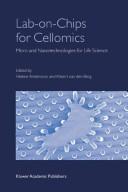
ISBN: 1280190841 9781402029756 9786610190843 1402029756 1402028601 Year: 2004 Publisher: Dordrecht, Netherlands : Springer Science Business Media, B.V.,
Abstract | Keywords | Export | Availability | Bookmark
 Loading...
Loading...Choose an application
- Reference Manager
- EndNote
- RefWorks (Direct export to RefWorks)
Dear reader, In the past few years we have observed an interesting mutual interest of two fields of research and development in each other. Life sciences area researchers discovered the opportunities offered my micro- and nanotechnology, while people from the microfluidics and BIOMEMS area discovered the application potential of these technologies in cell biology. Unfortunately, these two research communities share little in common: they read and publish in different scientific journals, have incompatible jargons, attend separate conferences, and have a different scientific approach and culture. This is most strikingly illustrated when you give a MEMS researcher some cells to experiment with, or hand over a couple of chips to a cell biologist. Or imagine explaining a microengineer different intracellular apoptotic pathway or a cell biologist about tensile stress in underetched LPCVD membranes. And yet, there is an enormous potential of combining the expertises available in these two fields. It is our goal to illustrate this potential with this book focusing on microfluidics technologies for “cellomics”, research on or with cells. In our view, the field is still too immature to compile a textbook for students, and this volume is rather meant to be a collection of first class papers of leaders in this emerging field. This volume will enable researchers from both communities to get a rapid “state of the art” overview, and also to get an impression what kind of possibilities this area offers. Micro- and nanotechnologists will get inspiration about applications, life science researchers about technological capabilities.
Cytology --- Artificial cells. --- Cell culture. --- Bioengineering. --- Nanotechnology. --- Technique. --- Medicine. --- Analytical biochemistry. --- Biotechnology. --- Cytology. --- Electronics. --- Biomedicine general. --- Analytical Chemistry. --- Cell Biology. --- Electronics and Microelectronics, Instrumentation. --- Analytical chemistry. --- Cell biology. --- Microelectronics. --- Biomedicine, general. --- Microminiature electronic equipment --- Microminiaturization (Electronics) --- Electronics --- Microtechnology --- Semiconductors --- Miniature electronic equipment --- Electrical engineering --- Physical sciences --- Cell biology --- Cellular biology --- Biology --- Cells --- Chemical engineering --- Genetic engineering --- Analysis, Chemical --- Analytic chemistry --- Chemical analysis --- Chemistry, Analytic --- Chemistry --- Health Workforce --- Cultures (Biology) --- Cells, Artificial --- Microcapsules (Biology) --- Technique
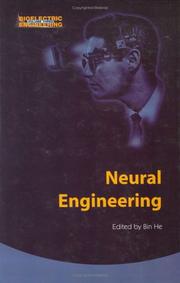
ISBN: 1281334081 9786611334086 0306486105 0306486091 Year: 2004 Publisher: New York : Kluwer Academic/Plenum Publishers,
Abstract | Keywords | Export | Availability | Bookmark
 Loading...
Loading...Choose an application
- Reference Manager
- EndNote
- RefWorks (Direct export to RefWorks)
About the Series: Bioelectric Engineering presents state-of-the-art discussions on modern biomedical engineering with respect to applications of electrical engineering and information technology in biomedicine. This focus affirms Springer’s commitment to publishing important reviews of the broadest interest to biomedical engineers, bioengineers, and their colleagues in affiliated disciplines. Recent volumes have covered modeling and imaging of bioelectric activity, neural engineering, biosignal processing, bionanotechnology, among other topics. Key Features of this Volume: Neural Engineering, Bioelectric Engineering Volume 2, contains reviews and discussions of contemporary and relevant topics by leading investigators in the field. It is intended to serve as a textbook at the graduate and advanced undergraduate level in a bioengineering curriculum. The topics include: – Neural Prostheses – Neural Interfacing – Neural Robotics – Functional Neural Stimulation – Neural Imaging – Neural Computation – Neural Networks – Neural System Identification and Prediction – Retinal Neuroengineering This principles and applications approach to neural engineering is essential reading for all academics, biomedical engineers, neuroscientists, neurophysiologists, and industry professionals wishing to take advantage of the latest and greatest in this emerging field. About the Editor: Bin He, PhD., IEEE Fellow, is a leading figure in the field of bioelectric engineering. An internationally recognized scientist with numerous publications, Dr. He has served as the President of the International Society of Bioelectromagnetism and as an Associate or Guest Editor for nine international journals in the field of biomedical engineering. Dr. He is currently Professor of Biomedical Engineering at the University of Minnesota.
Nanostructures. --- Biomedical materials. --- Biotechnology. --- Chemical engineering --- Genetic engineering --- Biocompatible materials --- Biomaterials --- Medical materials --- Medicine --- Biomedical engineering --- Materials --- Biocompatibility --- Prosthesis --- Nanoscience --- Physics --- Medicine. --- Biomedical engineering. --- Neurosciences. --- Radiology, Medical. --- Biomedicine general. --- Biomedical Engineering and Bioengineering. --- Biological and Medical Physics, Biophysics. --- Imaging / Radiology. --- Clinical radiology --- Radiology, Medical --- Radiology (Medicine) --- Medical physics --- Neural sciences --- Neurological sciences --- Neuroscience --- Medical sciences --- Nervous system --- Clinical engineering --- Medical engineering --- Bioengineering --- Biophysics --- Engineering --- Clinical sciences --- Medical profession --- Human biology --- Life sciences --- Pathology --- Physicians --- Biophysics. --- Biological physics. --- Radiology. --- Biomedicine, general. --- Health Workforce --- Radiological physics --- Radiation --- Biological physics --- Biology
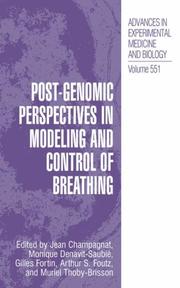
ISBN: 1283250551 9786613250551 038727023X 9780387270234 0306485079 9780306485077 Year: 2004 Publisher: New York : Kluwer Academic/Plenum Publishers,
Abstract | Keywords | Export | Availability | Bookmark
 Loading...
Loading...Choose an application
- Reference Manager
- EndNote
- RefWorks (Direct export to RefWorks)
Post Genomic Perspectives in Modeling and Control of Breathing is comprised of the proceedings of the IXth Oxford Conference on Modeling and Control of Breathing, held September 13-16, 2003 in Paris, France. This publication is placed within the general framework of post-genomic neurobiology, pathology, and the precise example of the rhythmic respiratory neural assembly being used to understand how genetic networks have been selected and conserved in the vertebrate brain. Specific topics include: ion channels and synapses responsible for respiratory rhythmogenesis and plasticity; pre- and post-natal development of the respiratory rhythm; chemosensory transduction and chemo-afferent signalling. These valuable insights open new avenues as to why the genetic codes underlying a vital function such as breathing have been selected, conserved, or optimized during evolution – a major issue of post-genomic biology. This critical issue will be considered from both top-down and bottom-up integrative modeling standpoints, with a view to elucidating the functional genomics linking discrete molecules to the integrated system that regulates breathing.
Respiration --- Regulation --- Respiration -- Regulation -- Congresses. --- Respiratory Mechanics -- genetics -- Congresses. --- Respiratory Mechanics -- physiology -- Congresses. --- Respiratory Mechanics --- Respiratory Physiological Processes --- Respiratory Physiological Phenomena --- Medicine. --- Neurosciences. --- Pathology. --- Biomedicine. --- Disease (Pathology) --- Medical sciences --- Diseases --- Medicine --- Medicine, Preventive --- Neural sciences --- Neurological sciences --- Neuroscience --- Nervous system --- Clinical sciences --- Medical profession --- Human biology --- Life sciences --- Pathology --- Physicians
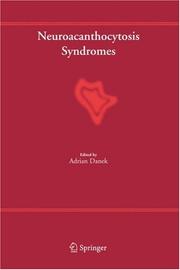
ISBN: 1402028970 9786610624126 1280624124 1402028989 Year: 2004 Publisher: Dordrecht ; Norwell, MA : Springer,
Abstract | Keywords | Export | Availability | Bookmark
 Loading...
Loading...Choose an application
- Reference Manager
- EndNote
- RefWorks (Direct export to RefWorks)
Neuroacanthocytosis Syndromes is the first comprehensive review of a field that has not yet received the attention it deserves. Affecting the brain as well as the circulating red cells, these multi-system disorders in the past had often been mistaken for Huntington's disease. Recent breakthroughs have now identified the molecular basis of several of these. This volume grew out of the first international scientific meeting ever devoted to neuroacanthocytosis and provides in-depth information about the state of the art. Its thirty chapters were written by the leading authorities in the field to cover the clinical as well as the basic science perspective, including not only molecular genetics but also experimental pharmacology and cell membrane biology, among others. The book vehemently poses the question of how the membrane deformation of circulating red blood cells relates to degeneration of nerve cells in the brain, the basal ganglia, in particular. It provides a wealth of data that will help to solve an intriguing puzzle and ease the suffering of those affected by one of the neuroacanthocytosis syndromes.
Brain. --- Brain - Diseases - Molecular aspects. --- Erythrocytes. --- Brain --- Erythrocytes --- Chorea --- Dyskinesias --- Neurologic Manifestations --- Movement Disorders --- Nervous System Diseases --- Signs and Symptoms --- Central Nervous System Diseases --- Pathological Conditions, Signs and Symptoms --- Diseases --- Neurology --- Medicine --- Health & Biological Sciences --- Molecular aspects --- Red blood cells --- Red blood corpuscles --- Red cells --- Cerebrum --- Mind --- Molecular aspects. --- Medicine. --- Human genetics. --- Neurosciences. --- Biomedicine. --- Human Genetics. --- Blood cells --- Central nervous system --- Head
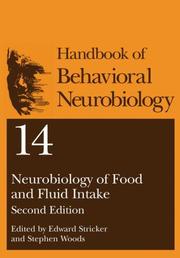
ISBN: 1280618523 9786610618521 0306486431 0306484846 Year: 2004 Publisher: New York, New York : Plenum Publishers,
Abstract | Keywords | Export | Availability | Bookmark
 Loading...
Loading...Choose an application
- Reference Manager
- EndNote
- RefWorks (Direct export to RefWorks)
Like previous handbooks, the present volume is an authoritative and up-to-date compendium of information and perspective on the neurobiology of ingestive behaviors. It is intended to be stimulating and informative to the practitioner, whether neophyte or senior scholar. It is also intended to be accessible to others who do not investigate the biological bases of food and ?uid ingestion, who may teach aspects of this material or simply wonder about the current state of the ?eld. To all readers, we present this handbook as a progress report, recognizing that the present state of the ?eld is much farther along than it was the last time a handbook was published, but mindful of the likelihood that it is not as far along as it will be when the next handbook is prepared. This ?eld has witnessed a spectacular accretion of scienti?c information since the ?rst handbook was published in 1967. During the generation of science between then and the publication of the second handbook in 1990, numerous scienti?c reports have substantially changed the perspective and informational base of the ?eld.
Medicine. --- Neurosciences. --- Nutrition. --- Psychiatry. --- Health psychology. --- Biomedicine. --- Health Psychology. --- Psychology, clinical. --- Nutrition . --- Medicine and psychology --- Mental health --- Psychology, Pathological --- Health psychology --- Health psychology, Clinical --- Psychology, Clinical health --- Psychology, Health --- Salutogenesis --- Clinical psychology --- Alimentation --- Food --- Nutrition --- Health --- Physiology --- Diet --- Dietetics --- Digestion --- Food habits --- Malnutrition --- Neural sciences --- Neurological sciences --- Neuroscience --- Medical sciences --- Nervous system --- Health aspects --- Hunger --- Religious aspects --- Christianity.
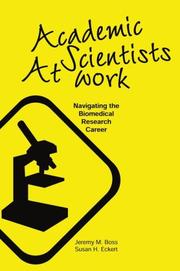
ISBN: 9780306474934 030647493X 9780306483813 9786610618408 128061840X 0306483815 Year: 2004 Publisher: New York : Kluwer Academic Publishers,
Abstract | Keywords | Export | Availability | Bookmark
 Loading...
Loading...Choose an application
- Reference Manager
- EndNote
- RefWorks (Direct export to RefWorks)
Academic Scientists at Work guides the scientist on the journey from the end of a postdoctoral career to the point of promotion to Associate Professor. The book includes valuable advice on: -Choosing and getting your ideal academic job; -Setting up and effectively managing the lab; -Obtaining funds; -Teaching and mentoring; -The promotion and tenure process. Also offered are template worksheets and point-by-point instructions on how to complete them, with downloadable blank worksheet versions contained in the accompanying CD-ROM. Included are six database program files that can be used to help the reader organize his/her laboratory specific reagents. Academic Scientists at Work is a valuable resource for the Career Scientist who demands and expects the best.
Scientists --- Research. --- Research --- Scientifiques --- Recherche --- Vocational guidance. --- Orientation professionnelle --- Education. --- Life sciences. --- Medicine. --- Research - Vocational guidance. --- Science_xStudy and teaching. --- Scientists. --- Science --- Education --- Psychology, Industrial --- Choice Behavior --- Psychology, Educational --- Psychology, Applied --- Natural Science Disciplines --- Decision Making --- Anthropology, Education, Sociology and Social Phenomena --- Thinking --- Disciplines and Occupations --- Psychological Phenomena and Processes --- Mental Processes --- Psychiatry and Psychology --- Vocational Guidance --- Career Choice --- Teaching --- Physical Sciences & Mathematics --- Sciences - General --- Vocational guidance --- Science education. --- Education, general. --- Science Education. --- Life Sciences, general. --- Biomedicine general. --- Study and teaching. --- Biomedicine, general. --- Health Workforce --- Biosciences --- Sciences, Life --- Science education --- Scientific education --- Children --- Education, Primitive --- Education of children --- Human resource development --- Instruction --- Pedagogy --- Schooling --- Students --- Youth --- Civilization --- Learning and scholarship --- Mental discipline --- Schools --- Training --- Science as a profession --- Science research --- Scientific research --- Information services --- Methodology --- Research teams
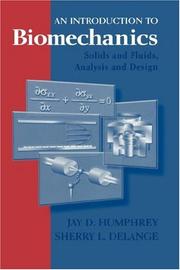
ISBN: 0387402497 9780387402499 1441923187 1489903259 Year: 2004 Publisher: Berlin ; Heidelberg ; New York, NY [etc.] : Springer-Verlag,
Abstract | Keywords | Export | Availability | Bookmark
 Loading...
Loading...Choose an application
- Reference Manager
- EndNote
- RefWorks (Direct export to RefWorks)
Designed to meet the needs of undergraduate students, Introduction to Biomechanics takes the fresh approach of combining the viewpoints of both a well-respected teacher and a successful student. With an eye toward practicality without loss of depth of instruction, this book seeks to explain the fundamental concepts of biomechanics. With the accompanying web site providing models, sample problems, review questions and more, Introduction to Biomechanics provides students with the full range of instructional material for this complex and dynamic field.
Biomechanics. --- Biomécanique --- Biomécanique --- Biomechanical Phenomena. --- Biophysics. --- Biological physics. --- Biomedical engineering. --- Mechanics. --- Mechanics, Applied. --- Human physiology. --- Medicine. --- Biochemical engineering. --- Biological and Medical Physics, Biophysics. --- Biomedical Engineering and Bioengineering. --- Theoretical and Applied Mechanics. --- Human Physiology. --- Biomedicine, general. --- Biochemical Engineering. --- Bio-process engineering --- Bioprocess engineering --- Biochemistry --- Biotechnology --- Chemical engineering --- Health Workforce --- Human biology --- Medical sciences --- Physiology --- Human body --- Applied mechanics --- Engineering, Mechanical --- Engineering mathematics --- Classical mechanics --- Newtonian mechanics --- Physics --- Dynamics --- Quantum theory --- Clinical engineering --- Medical engineering --- Bioengineering --- Biophysics --- Engineering --- Medicine --- Biological physics --- Biology --- Biomechanics
| Listing 1 - 10 of 15 | << page >> |
Sort by
|

 Search
Search Feedback
Feedback About UniCat
About UniCat  Help
Help News
News